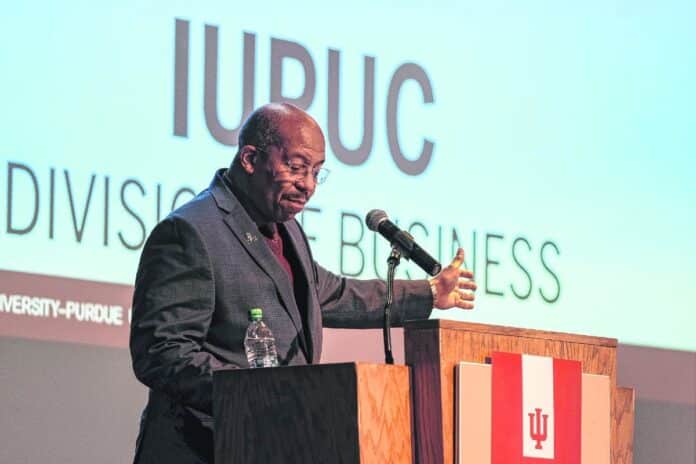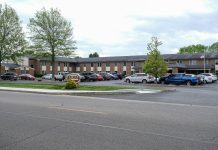
Community leaders and educators gathered virtually Tuesday to discuss the importance of encouraging diversity and uncovering bias.
These speakers shared experiences and solutions during "Unveiling the Bias," the latest installment in the Lead by Design series presented by IUPUC’s Center for business and Economic Development. The series focuses on diversity in the community and how it can fuel economic development.
“It’s incredible that we all get to be able to participate in this dialogue, despite being away from each other," said Nicole Pence, event moderator and owner of Pence Media Group. "… This is the third time we’ve been able to come together and say, ‘This is a conversation that we want to prioritize. This is dialogue that we want to be a part of. These are solutions that we want to hear from other people.’”
The event was free, with members of the community registering and attending the discussion via Zoom. In addition to presentations from speakers, the event also included participatory elements, such as poll questions and 5- to 15-minute breakout rooms.
[sc:text-divider text-divider-title=”Story continues below gallery” ]
In these rooms, small groups of audience members discussed topics presented by speakers and questions offered by Pence. While the main session was recorded by IUPUC, these smaller groups were left private.
The event’s first speaker was Mark Stewart, president of United Way of Bartholomew County. Stewart also serves on the boards of the Heritage Fund, Community Education Coalition, Healthy Communities and the Alliance for Substance Abuse Progress.
Stewart focused on community demographics regarding diversity in Columbus. He said that population growth helps contribute to a "healthy economy."
“Over the past decade, our community has had healthy population growth at about 9 percent," he said. "However, it’s important to recognize that about 90% of that population growth came from people of color. In 2010, the population of Bartholomew County was about 90% white. Today, it’s about 80% white. And within BCSC … the white population represents 70%.”
Stewart emphasized that while our community is becoming more diverse, our leadership does not necessarily reflect this diversity. One study by the Heritage Found that out of 94 local boards, commissions and committees, only six reflected the "demographic makeup of our community."
In addition, Stewart added that not all diverse people groups find Columbus to be a "welcoming" place to live, especially the LGBTQ community, which was shown to be the "least likely" to feel welcome in our community in a recent survey by the Heritage Fund. He said that the community is "missing out on a lot of talent" from groups who may not feel welcomed in Columbus.
“After engaging in equity work for the past few years, it is now my viewpoint that Columbus is not as welcoming as I have always believed that it is," Stewart said. "There are definitely parts and pieces of our community that are welcoming. However, there are significant parts of our community that are not at all inclusive. Some have described this phenomenon as the ‘Columbus bubbles of inclusivity.’”
Kevin Jones, associate professor of management at IUPUC, talked about how "design thinking" and creative problem-solving can help people find solutions to promoting diversity and addressing bias.
“It (bias) is something that can be managed," he said. "This is something we can figure out. Is it a problem to be eliminated? Well, that’s debatable. Can we eliminate it? I’m not going to say we can’t, but I’m going to say that that’s a little harder. The challenge for us is what can we do with our biases?”
Jones also pushed for people to look beyond old approaches and consider new ideas for confronting problems such as bias or lack of diversity.
“We should not limit ourselves to think, ‘Well, we’ve thought of everything, and we’ve tried things that haven’t worked,’" he said. "No, we have to continue to work towards finding new pathways, new combinations of ideas, to try to work ourselves toward our desired goals.”
The next presenter, Julie Goodspeed-Chadwick, focused on identity politics and stereotypes, particularly those that affect women in the workplace. Goodspeed-Chadwick is an IUPUI Chancellor’s Professor of English; affiliate faculty in Women’s, Gender, and Sexuality Studies; and the founding Director of the Office of Student Research at IUPUC.
Due to a common bias that associates masculinity with strength in leadership, women make up “the smallest fraction of CEOs and assume far fewer paid leadership positions in our culture and society, when compared to men," she said.
As biases and identity politics play out, different groups become victims of stereotype threat, Goodspeed-Chadwick said.
“Stereotype threat is when you realize, by virtue of your identity, that you are perceived in certain ways and that if you somehow do not succeed in whatever endeavor it might be — for instance, the workplace — then you are inadvertently reaffirming the stereotypes about people like you," she explained.
Leaders should work on "fostering empowerment in our workplaces in ways that support diversity, promote inclusion and counter prevailing biases." To that end, she emphasized the importance of listening to other people’s ideas and experiences, as well as providing validation and a sense of community, Goodspeed-Chadwick said.
Marsha VanNahmen, assistant director of the Center for Learning and Teaching at IUPUC, also addressed the danger of biases.
“I am not an authority on bias, but implicit bias unnerves me in the same way that a scorpion does," she said. "You all know scorpions are those little poisonous creatures that blend in and almost disappear in the environment.”
Explicit bias, on the other hand, is more like a diamondback or rattlesnake — "You know it when you hear it," she said.
VanNahmen related her own experience with bias in the workplace. At the age of 20, she worked for a heavy equipment manufacturer in Illinois as an assistant supervisor in an assembly department. However, men working around her didn’t think a woman should be in that position.
"If these individuals, with their likely bias about females in a manufacturing environment, had been in a position to make the decision about hiring me, I would never have had that opportunity," she said.
VanNahmen added, however, that we can take steps to recognize our biases and confront them. She pointed to Implicit Association Tests, which can help uncover a person’s biases about different groups.
“Biases can be modified," she said. "We’re not helpless in the face of our first automatic reaction. In addition, to improve self-awareness there are things we can do, practices we can adopt that deny bias the chance to influence decisions and, consequently, behaviors.”
The event concluded with a word of encouragement from Jones, who quoted John Lewis and reminded audience members that all individuals are part of the same "human family."
“If we strive with that point in mind, we will not be discouraged," he said. "We can be united. And all of us, together, can make a difference. Yes, individually, and connectedly. We cannot reach perfection, but if we move forward and we keep pushing forward, we find ourselves realizing something that maybe we didn’t see when we started.”
[sc:pullout-title pullout-title=”About Lead by Design” ][sc:pullout-text-begin]
Lead by Design is a series of discussions about diversity in the community, with a specific focus on how diversity can fuel economic development.
Tuesday’s event was sponsored by Innovate Indiana, the Columbus Chamber of Commerce, Columbus Rotary and Viewpoint Books.
[sc:pullout-text-end][sc:pullout-title pullout-title=”Survey says…” ][sc:pullout-text-begin]
The following is a summary of poll results from the virtual discussion. While results were displayed, the number of respondents and their individual answers remained private.
“Of the Boards of Directors of which you are familiar, does the board composition reflect our community? Our community is 50% female and at least 18% people of color.”
- No – 100%
- Yes – 0%
“Unconscious bias is”
- Something that can be managed – 71%
- A problem to be eliminated – 29%
- Not a concern – 0%
- Doesn’t really exist – 0%
“Have you ever been conscious of being subjected to a stereotype threat?”
- Yes – 96%
- No – 4%
These final two questions were posed as a sort of "pop quiz" by speaker Marsha VanNahmen.
“Implicit or unconscious bias"
- Is activated involuntarily – 43% (Correct answer)
- Often reflects our beliefs and values – 4%
- Cannot be modified or unlearned – 0%
- All of the above – 52%
“Explicit or conscious bias”
- May be shaped by life experiences – 9%
- Often reflects our feelings and attitudes – 0%
- May be expressed verbally or physically – 0%
- All of the above – 91% (Correct answer)
[sc:pullout-text-end][sc:pullout-title pullout-title=”Pull Quote” ][sc:pullout-text-begin]
“After engaging in equity work for the past few years, it is now my viewpoint that Columbus is not as welcoming as I have always believed that it is. There are definitely parts and pieces of our community that are welcoming. However, there are significant parts of our community that are not at all inclusive. Some have described this phenomenon as the ‘Columbus bubbles of inclusivity.’”
— Mark Stewart, United Way of Bartholomew County
[sc:pullout-text-end]




